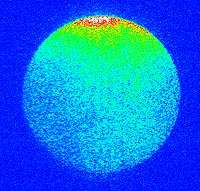Hydrogen flame spread in an Internal Combustion Engine
Primary tabs
In June 2006 images of hydrogen combustion were captured for the first time in an internal combustion engine operating at real-world speeds and loads by engineers at the U.S. Department of Energy's Argonne National Laboratory.

Argonne engineers are the first to capture hydrogen combustion images inside an engine operating at real-world speeds. The red and yellow images show the more intense temperatures.
See https://phys.org/news/2006-06-images-hydrogen-internal-combustion.html
This gave a window into the inner workings of a hydrogen-powered engine. A few years ago, their X-ray images of combustion inside a diesel engine revealed a surprising shock wave as diesel fuel spurted out of the fuel injector. Why do you think diesels rattle so much? Duh . . . it is the explosive nature of oil hitting hot, compressed, air Much like when water hits hot oil.
"Hydrogen-powered internal combustion engines (ICEs) are a low-cost, near-term technology," explained mechanical engineer Steve Ciatti, who is the project's principal investigator.
Some automakers are already viewing hydrogen ICEs as a near-term bridge to the use of fuel cells in vehicles, Ciatti said. Both Ford and BMW already have demonstration fleets gathering data.
By using imaging tools and other standard engine measurement devices on a Ford Motor Co. single-cylinder, direct-injection hydrogen engine, Argonne mechanical engineers Ciatti, Henning Lohse-Busch and Thomas Wallner are optimizing engine operation and identifying the root causes of combustion anomalies, such as pre-ignition and knock. These problems are more pronounced at high speeds and high loads. Argonne researchers observe 50 performance measurements during each engine test.
Researchers used ultraviolet imaging to capture images inside the running engine. "Hydrogen's visible radiation signature is barely discernible, so we focused on the chemical reactions of hydrogen and oxygen, called OH chemiluminescence, in the engine," Ciatti said. These reactions emit photons in the ultraviolet energy range, and that light is captured and analyzed with specialized optics.
"Hydrogen ICEs are a lot like gasoline engines, except the fuel is gaseous instead of liquid," Ciatti said. Hydrogen has wide flammability limits, so the engine might not even need a throttle, unless bi-fueled as it a device that chokes the air/fuel mixture to control the engine power and hampers efficiency (a standard car today is 25 percent efficient; a hydrogen car will be close to 45 percent efficient), nor do they require exhaust after-treatment when operating correctly.
Hydrogen's high flame speed also offers a chance to increase the power output without increasing engine size. Using a direct injection of hydrogen, the power density is roughly 117 percent that of an equivalent gasoline engine – and hydrogen ICEs start easily in cold weather. However, unlike liquid fuels, hydrogen has low energy density per unit volume – which means the vehicle will have somewhat limited range by comparison if running on tanked hydrogen, but an on the fly fueled hydrogen internal combustion engine propelled vehicle is the ideal vehicle - able to fuel almost anywhere water is found.
"The unique properties of hydrogen fuel (wide air fuel ratio flammability limits and the ignition characteristics) are exciting because you can do things with hydrogen that you can't do with hydrocarbons," Ciatti said. “For example, you can use direct injection (spraying the fuel directly into the combustion chamber), so the efficiency goes up and the power density goes up, but unfortunately the complexity goes up as well.”
Because of its nature, hydrogen easily combusts in a wide air fuel ratio, but under pressure does not autoignite until around 1200 degrees Fahrenheit, so researchers are experimenting with a multiple injection approach. They are injecting hydrogen directly into the cylinder once or twice during each combustion cycle, depending upon operating conditions. The goal is to determine the optimum timing and amount of hydrogen injected each cycle. The wrong mixture of hydrogen causes engine operation and emission problems.
The researchers are also experimenting with prototype injectors. Making them is a materials science and engineering challenge because the operating atmosphere is unusually hot and under high pressure. Sealing and cooling the injector becomes a critical task.
"Working with a single cylinder allows us to isolate problems so we don't have four cylinders to track through to see where and how problems started," explained Ciatti.
"We plan to solve problems in the single cylinder and then try them out in a four-cylinder," said Ciatti. The mechanical engineering team has installed a 2.3 liter four-cylinder Ford hydrogen engine and is commissioning it. Eventually, the team will integrate the four-cylinder engine into a flexible hybrid vehicle to test how the engine operates as part of a vehicle in Argonne's Advanced Powertrain Research Facility.
HOWEVER the issue with today's street legal vehicles and Hydrogen is the Oxygen Sensor which must see a hydrocarbon fuel being exhausted and tries to set an air fuel ration based on a hydrocarbon fuel. This challenge we have solved, as does bi-fueling also
| Attachment | Size |
|---|---|
| 7.89 KB |
